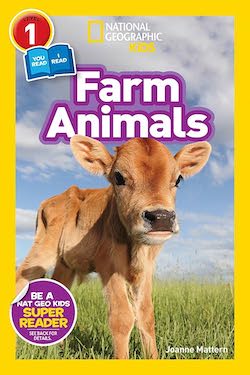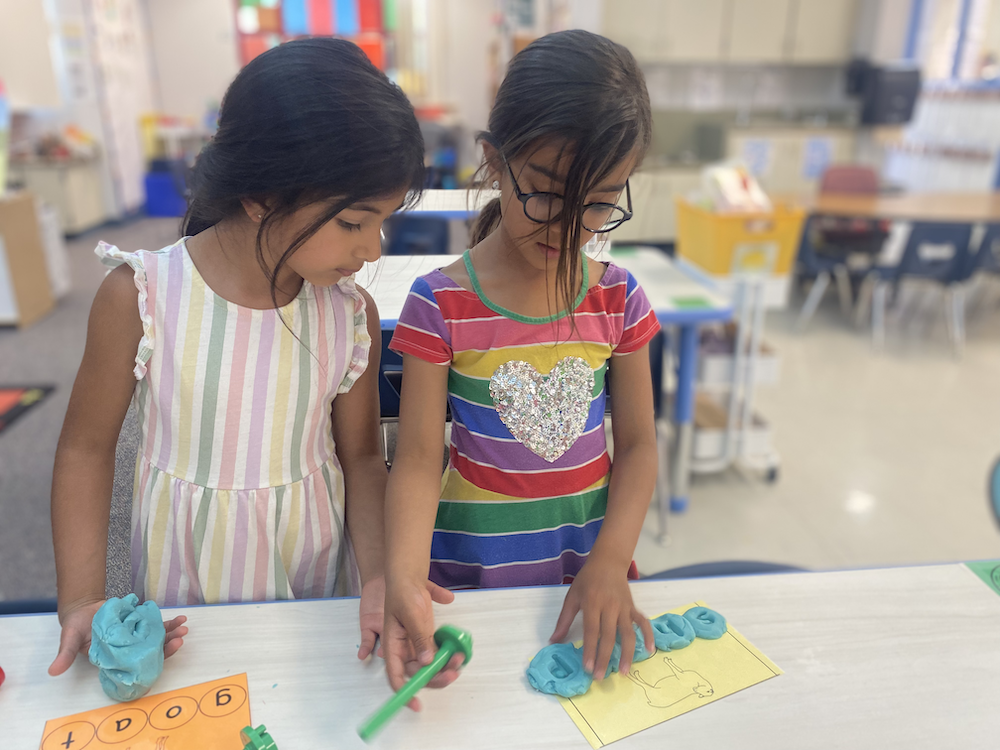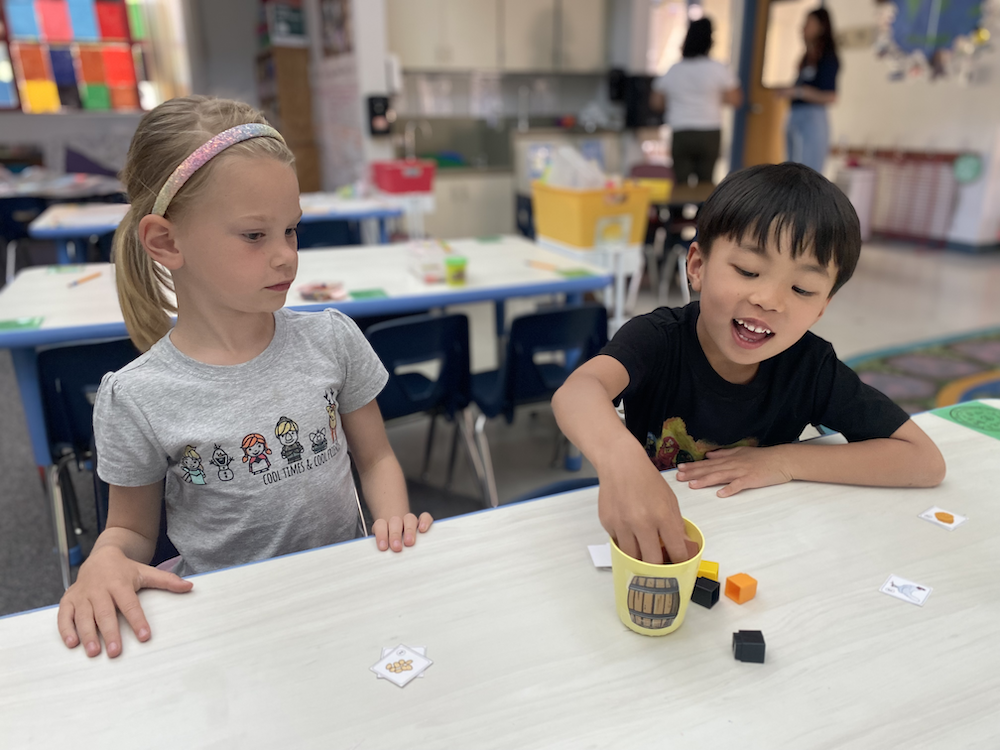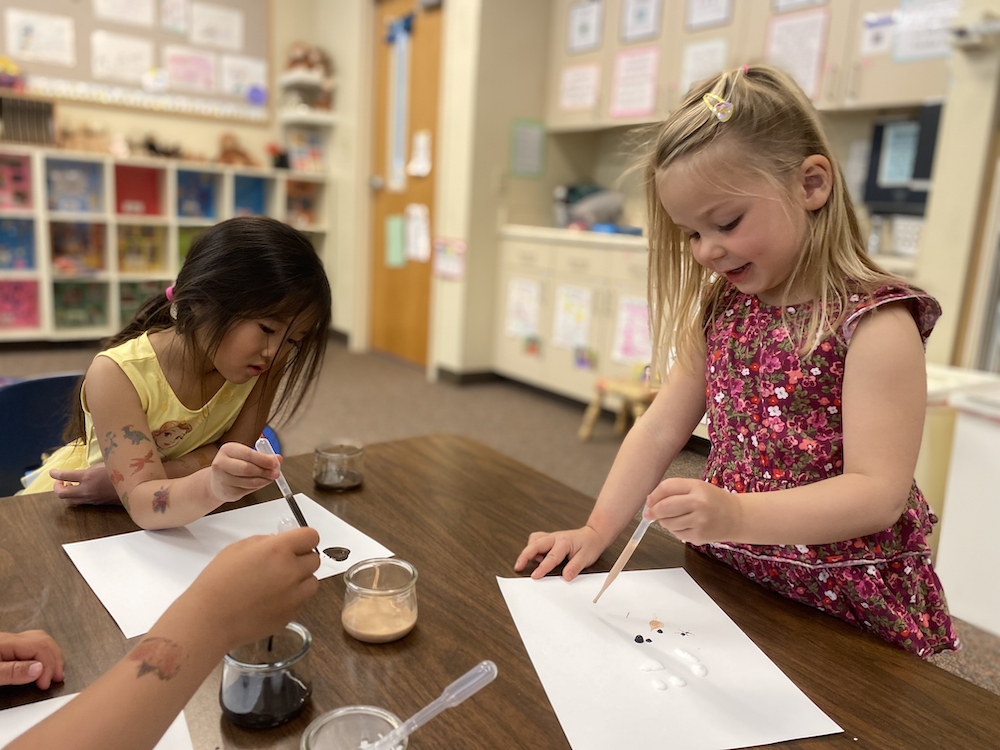Agricultural Literacy Curriculum Matrix
Lesson Plan
Animals on the Farm
Grade Level
Purpose
Students discover that farm animals produce different types of products. Grades PreK-K
Estimated Time
Materials Needed
Engage:
Circle Time: Animal Product Match
- National Geographic Kids: Farm Animals by Joanne Mattern
- Vocabulary Development Photo Cards (Prior to the lesson, cut and laminate the cards for future use)
- Animal Product Match Cards
- Pocket chart
Literacy: Playdough Stamp Mats
- Playdough Stamp Mats (Prior to the lesson, print on bright paper and laminate the mats for future use)
- Playdough
- Alphabet stamps
Math: Feeding Time
- Large plastic cup (1 per group of 3-4 students)
- Feeding Time Barrel Graphic (Prior to the lesson, print, cut, and tape to each plastic cup)
- Counters (20 per group, use natural colors, such as brown, yellow, or green)
- Feeding Time Cards (1 set per group)
Art: Cowhide Art
- The Kindergarten Rancherby Rachel Gabel
- White cardstock
- Tempera paints (red, brown, black, tan, and gray in small containers)
- Droppers
Vocabulary
by-product: an incidental or secondary product made in the manufacture or synthesis of something else
livestock: farm animals (such as cows, horses, and pigs) that are kept, raised, and used by people
Background Agricultural Connections
In an effort to simplify the idea of where food comes from, many early learners are implicitly taught that most farms look like the farms of the past: a single family living and working on a farm to provide for their day-to-day needs. In the past, the entire family would work on the farm and there was always work to be done. Typically, these farms would grow many different fruits and vegetables, with a big barn that housed a variety of livestock animals: a small brood of chickens, a horse, several cows and pigs, and a small herd of sheep. The family's food came from their own farm. Although some farms are still like that, today we get most of our food from much larger farms—still family owned—that specialize in growing one type of food. There are egg farms, dairy farms, almond farms, and apple farms. Modern farms require specialized knowledge, skills, and machinery in order to survive in the global marketplace.
This lesson is part of a series called, Life on the Farm. The remaining lessons can be found at the following links:
- All Kinds of Farms
- Animals on the Farm
- Crops on the Farm
- Machines on the Farm
- Thank You Farmers
Farm animals or livestock are an important part of our nation's agricultural industry and an important part of our survival. Not only do these animals serve to produce food (milk, meat, and eggs) high in protein, vitamins, and minerals; they also provide many by-products (leather, wool, medical products, etc.) which we cannot live without.
Engage
- Display the Farm Animal Pictures to show the six major farm animals (beef cattle, dairy cattle, pigs, sheep, chickens, turkeys).
- Ask the students to name the farm animals.
- Explain to the students that they will be learning about farm animals and the different products they produce.
Explore and Explain
Circle Time: Animal Product Match
 Read the book, National Geographic Kids: Farm Animals by Joanne Mattern. (Teacher Note: This book includes three chapters. Depending on the attention span of your students, you may wish to only read the first chapter or read the entire book over the course of an entire day.)
Read the book, National Geographic Kids: Farm Animals by Joanne Mattern. (Teacher Note: This book includes three chapters. Depending on the attention span of your students, you may wish to only read the first chapter or read the entire book over the course of an entire day.)- After reading, review the Vocabulary Development Photo Cards.
- Show the cards to the children and say the name of each photo on the card. Encourage the children to repeat the vocabulary words after you.
- Ask the children to identify the object or action on the card and describe what it is or does.
- Possible prompts:
- Dairy: Dairy is a type of food that comes from milk, which is produced by animals like cows, goats, and sheep. Cheese, butter, and yogurt are made with milk. Dairy foods are really good for you because they help build strong bones and teeth. What dairy products do you eat at home?
- Poultry: Poultry is a type of bird that farmers raise for food, like chickens, turkeys, and ducks. They provide us with many different types of food like chicken nuggets, turkey sandwiches, and eggs. What poultry products do you eat at home?
- Sheep: Sheep are fluffy animals found on farms. We use their wool to make clothes, and their meat for food. On the farm, they live in a fenced, grassy area called a pasture. How do their wooly coats feel?
- Pigs: A pig is a farm animal that provides us with meat like bacon, ham, and sausage. We call the meat from pigs "pork." What pork products do you eat at home?
- Beef Cattle: This word wasn't in our book today, but beef cattle are also farm animals. Beef cattle look similar to dairy cows, but beef cattle are raised for meat. Hamburgers and steaks are examples of foods made from beef. What beef products do you eat at home?
- Crops: Not all farmers raise animals. Some farmers grow crops. Animals eat crops, and people use crops to make food. Some crops include fruits like apples and oranges, vegetables like carrots and lettuce, and grains like wheat and rice. What crops do you see growing in our community?
- Play the matching game, Animal Product Match.
- Place the animal cards across the top of the pocket chart. Place the animal product cards at the bottom of the pocket chart, in no particular order. Before starting the game, review the animal cards, differentiating between the dairy cow (with udder), and the steer (used for beef).
- Invite students, one at a time, to approach the pocket chart and select an animal product card from the bottom of the chart. Help them correctly match the product to one of the animal cards at the top of the chart. When they make a match, they may place the card under the corresponding animal card. Repeat with the remaining cards.
- Introduce the concept of animal by-products. You can say something similar to, "The people who raise animals for meat often use all the parts of an animal to make sure nothing goes to waste. For example, they might use the cow's hide (skin) to make leather for shoes, belts, and purses. They might use the pig's bristles (hairs) to make brushes. They might even use the bones of the animal to make glue, or the fat to make candles and soap. When ranchers use all the parts of an animal, they are being responsible and making sure nothing goes to waste."
Literacy: Playdough Stamp Mats
 Explain to the students that they will use the playdough stamps to create farm animal words. There is a picture clue on each Playdough Stamp Mat and circles for each letter of the word.
Explain to the students that they will use the playdough stamps to create farm animal words. There is a picture clue on each Playdough Stamp Mat and circles for each letter of the word.- Invite the students to build an animal word. Have them look at the first circle (the first letter of the word) and find the corresponding letter stamp.
- Next, roll playdough into a small ball and smoosh it into the circle.
- Then, stamp the letter into the playdough.
- Repeat this process until the entire word is complete. Practice saying the word.
Math: Feeding Time Cooperative Game
Teacher Note: In this cooperative game, the players work together to achieve a common goal rather than trying to beat each other. This encourages teamwork, collaboration, and communication between the players.
 Review the different livestock animals they care for. For example, a dairy farmer may grow corn which is a nutritious food for cows. A pig farmer might grow turnips to feed their pigs.
Review the different livestock animals they care for. For example, a dairy farmer may grow corn which is a nutritious food for cows. A pig farmer might grow turnips to feed their pigs.- Introduce the students to the game, Feeding Time:
- To set up the game, place the cup in the center of the playing area and put 10 counters inside the cup and 10 counters next to it.
- Shuffle the deck of cards and place it face down near the cup.
- The first player picks up a card from the deck.
- If the player draws a crop card, it represents harvesting a crop and the player adds that number of counters to the barrel.
- If the player draws an animal card, it represents feeding the animals and the player removes that number of counters from the barrel.
- Play continues clockwise with each player taking a turn to draw a card and add or remove counters accordingly.
- The goal of the game is to always have counters in the barrel. If the group runs out of counters, they can start over. The game ends when all the cards have been drawn or when the players decide to stop playing.
- At the conclusion of the game, count the total number of counters in the cup. Have groups report how many counters remain in the cup and celebrate their success.
Art: Cowhide Art
- Read The Kindergarten Rancher by Rachel Gabel. Discuss how each breed of cattle is unique. They look different, and have different colored hair on their hide (skin). Review the different colors from the book.
- Explain that the ranchers who raise cattle for meat often use all the parts of an animal to make sure that nothing goes to waste. For example, they might use the cow's hide (skin) to make leather jackets, belts, shoes, and even furniture. It has a smooth, durable texture and that makes it great for these kinds of products.
 Introduce the cowhide art project.
Introduce the cowhide art project.
- Give each child a piece of white cardstock and a dropper.
- Show the children how to use the dropper to pick up paint from the bowls.
- Invite the children to drop the paint onto their paper in any pattern they like. They can make dots, lines, or shapes like circles or squares.
- Encourage the children to experiment with the dropper and the paint, and to make different patterns and shapes. They can also mix colors or try using different amounts of paint for different effects.
- Once the paintings are dry, create a wall collage of cowhide-inspired artwork.
Elaborate
- Use the About Farm Animals Mini Kit for students to learn more about what farm animals eat and what they produce.
- Visit a local farm to observe farm animals in person. Reinforce what the students have learned in the classroom by helping them recognize the names of various farm animals and what products they produce.
Evaluate
After conducting these activities, review and summarize the following key concepts:
- Farm animals such as cattle, sheep, pigs, chickens, and turkeys provide milk, meat, and eggs for humans to eat.
- In addition to the primary products they produce, farm animals also provide by-products.
- Farmers raise these animals and are responsible to care for them.
Recommended Companion Resources
- A Day in the Life of a Farmer
- A Young Shepherd
- About Farm Animals Mini Kit
- About...Books
- Barn at Night
- Down on the Farm: Pigs
- Ewe Bee Ewe: A Sheep Tail
- Farm
- Farm Animals
- Farm Animals in a Box
- Farm Animals: Chickens
- Farm Animals: Sheep
- Farm Pop-Ups
- From Sheep to Sweater
- I'm Thinking of a Farm Animal
- It's Milking Time
- Kindergarten Rancher
- Levi's Lost Calf
- Livestock Cards
- Livestock Flowchart
- My Family's Farm Book Series
- National Geographic Kids: Farm Animals
- Pigology: The Ultimate Encyclopedia
- Pigs
- Real Farm & Ranch Kids
- Sheep Crossing
- Sheep on the Farm
- Sheepology: The Ultimate Encyclopedia
- The Year at Maple Hill Farm
Author
Organization
| We welcome your feedback! If you have a question about this lesson or would like to report a broken link, please send us an email at matrixelearning@gmail.com. If you have used this lesson and are willing to share your experience, we will provide you with a coupon code for 10% off your next purchase at AgClassroomStore. |
